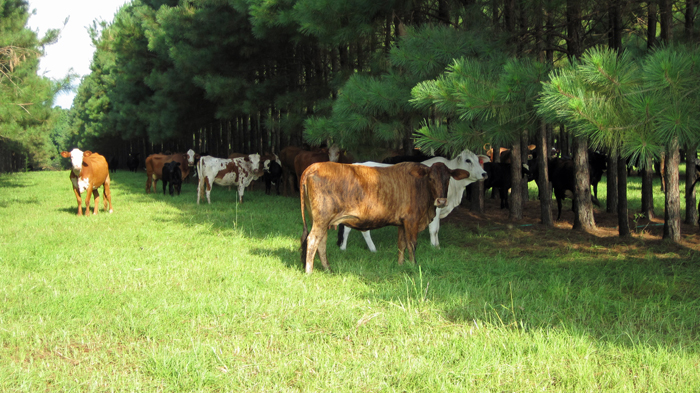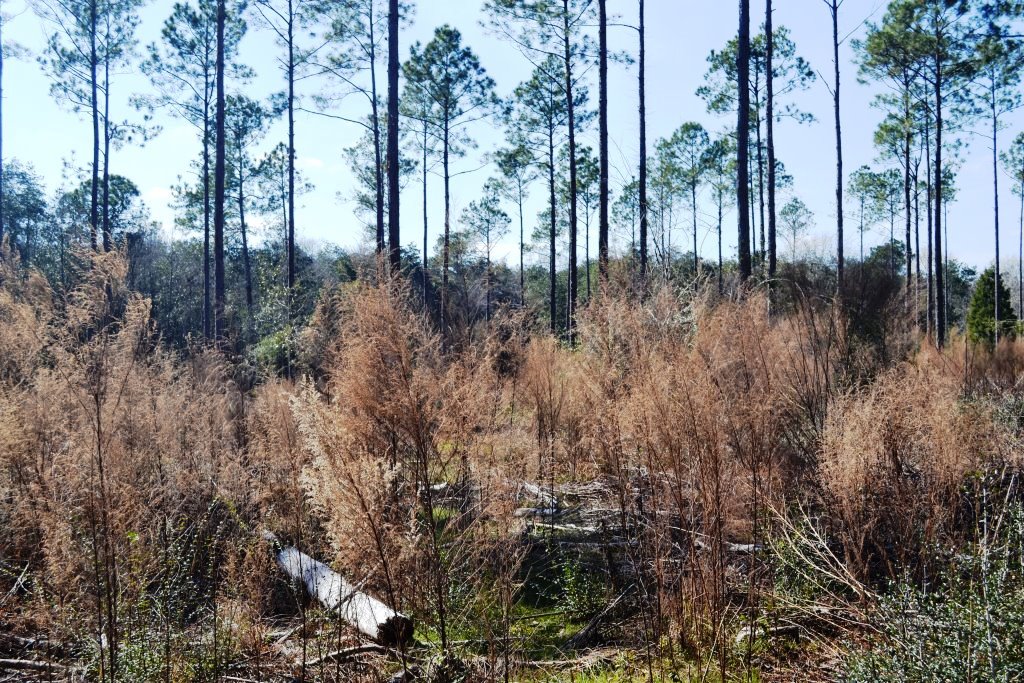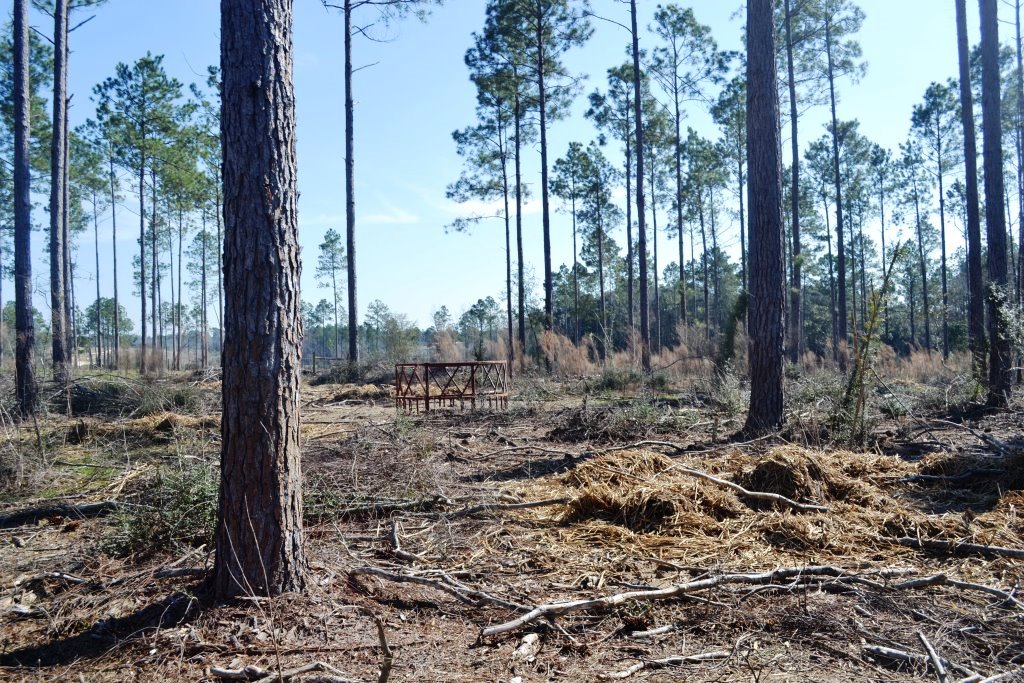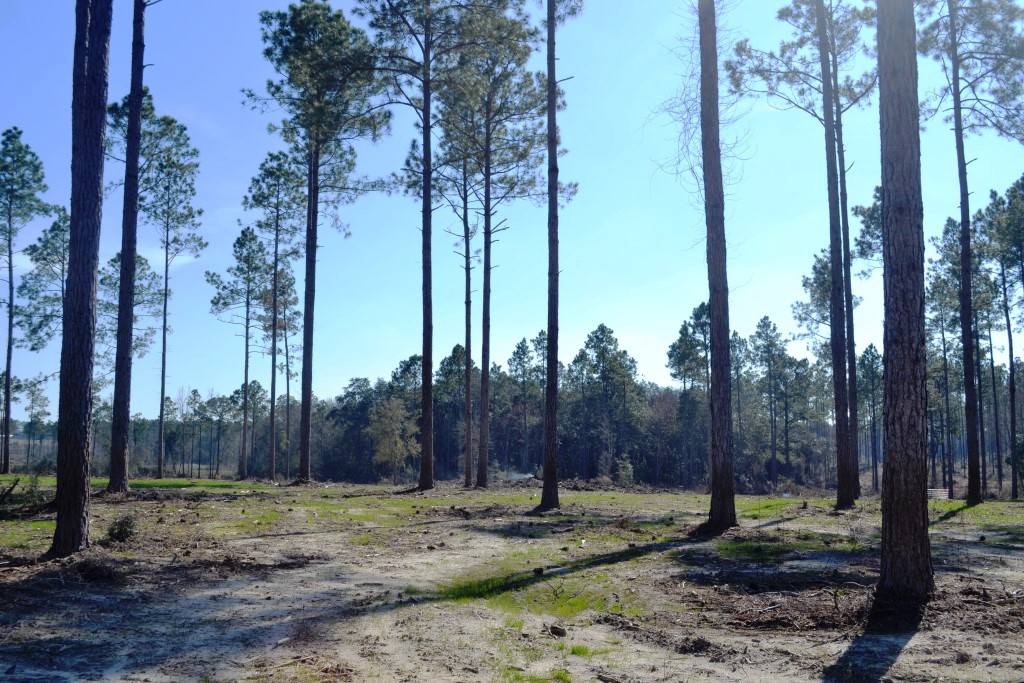
Silvopasture is an agricultural practice co-managing trees, forage, and livestock. Photo credit: Doug Mayo
Silvopasture is an agroforestry practice where a combination of trees, forage, and livestock are jointly managed to optimize production of all three. The term “silvopasture” means “forest-pasture,” where “silvo” is derived from a Latin word that means “forest.” Silvopasture can be established either by planting trees in an existing pasture, or by planting forage in an existing stand of trees. This article provides recommendations for converting planted pines to silvopasture.
Fully stocked pine stands, or previously thinned pine stands can be transitioned into Silvopasture over a two year period with proper management. Thinning pine stands to a 40-60 basal area, or approximately 150 trees per acre is ideal. The diameter of your trees at breast height (DBH) determines basal area and how many trees per acre you will have. A prism (10 factor for our area, cost around $40) is used to calculate the basal area. Contact your local state forester or consulting forester to show you how to use the prism to determine basal area.
Your new Silvopasture stand should consist of 2-3 solid rows of trees with 40 feet or more of open space between each set of rows. Make sure diseased and dead trees are removed from within the rows to keep the understory clean for forage production. Tree size and health needs to be considered per stand. Initial planning and management is important before logging commences. Natural pine stands can also be converted to Silvopasture, but the focus of this article is on conversion from planted pines.
Once the stand has been thinned, prescribed burning would be the next step, followed by a shallow disking (4-6 inches) to avoid tree root damage on existing pine trees. In some situations, an herbicide application may be needed to kill underbrush like yaupon holly and privet,if fire doesn’t do the job.
Soil testing to determine liming requirements is important as most pine stands have acidic soils. A pH of 5.5 – 6 would be ideal; a higher pH could negatively affect the growth of your pine trees.

Managing understory plants to establish grass in pines is a critical step in creating silvopasture. Photo by Mike Goodchild
Pensacola bahiagrass, combined with overseeded ryegrass in the winter are a proven combination for Silvopasture, both for establishment and financial considerations. Other varieties will work, but may be less adaptable or cost more. Depending on ground cover, various types of planting methods can be used to get your grass established. No till drills, three-point PTO spreader, or even using cows to stomp in your seed can be used. Different types of clover can also be planted with the ryegrass in the fall to provide a nitrogen source, which will benefit both trees and grass. Also the partial shade provided from the planted pines will extend the growing season for some of our less heat tolerant varieties of clover.
Stocking rates for cattle will depend on the amount of forage you have in the stand. Initially it will be low until ground cover is adequately covered with grass.

Using cattle to help open up understory and establish pasture is a benefit of Silvopasture. Photo by Mike Goodchild
Here is a summary of management activities needed for developing a Silvopasture grazing system in planted pine:
-
Thin planted pines to a 40-60 basal area
-
Burn stand to remove logging debris and underbrush
-
Bush hog, shallow disk, root rake, or use herbicide to expose soil for forage seed contact
-
Do a soil test to determine how much lime is needed
-
Plant seed using drills, spreaders, or cows *
-
Let grass get 6 inches tall before grazing
* Stumps usually take 5-6 years to rot without special treatment. Just plant around them the best you can. It is generally quite cost prohibitive to remove them all.
In summary, research has shown that timber production and cattle production can work well together, if managed properly. Diversification of agricultural land helps manage market risks, and can increase income over the long term. Cost-share programs for silvopasture may be available in your county through the Natural Resource Conservation Service (NRCS), to help offset some of the establishment costs. [important]Conservation Reserve Program (CRP) lands are not eligible for use as Silvopasture.[/important]
For more information on Silvopasture please see the following resources:
Integrated Timber, Forage and Livestock Production – Benefits of Silvopasture
Silvopasture: Establishment and management principles for pine forests in the Southeastern U.S.
USDA National Agroforestry Center
- What are the Benefits of Freezer Beef? - August 27, 2021
- Fire Management in a Silvopasture System - March 19, 2021
- Game Cameras for Wildlife Monitoring - October 2, 2020

